Development and Validation of HSPiP- and Optimization-Assisted Method to Analyze Tolterodine Tartrate in Pharmacokinetic Study
Abstract
:1. Introduction
2. Materials
3. Methods
3.1. HSPiP-Based Predicted Solvents and Combination Ratio
3.2. Measurement of Maximum Wavelength (λmax)
3.3. Experimental Solubility of TOT in the Predicted Solvents
3.4. Screening of Chromatographic Factors (Taguchi Model)
3.5. Selection of Chromatographic Parameters
3.6. Preparation of Standard Stock Solution
3.7. Optimized Mobile Phase Composition
3.8. The Combined Impact of the Selected Factors on Responses by Central Composite Design (CCD)
3.9. Method Validation to Estimate TOT from a Mixture and a Tablet
3.10. Application of the Proposed Method to Bulk Sample
3.11. Application of the Proposed Method to Tablet Formulation
3.12. Validation of the Proposed Method and Various Validation Parameters
3.13. Pharmacokinetic Study in Rats
3.14. Statistical Analysis
4. Results and Discussion
4.1. HSPiP-Based Predicted Solvents and Ratio
4.2. Measurement of λmax
4.3. Experimental Solubility of TOT in the Predicted Solvents
4.4. Selection of Critical Factors for Chromatography (Taguchi Model)
4.5. Impact of Factors on Peak Area and Retention Time: Optimization
4.6. Method Validation Parameters to Estimate TOT from Bulk and Tablets
4.7. Application of the Proposed Method to Bulk Samples and Tablets
4.8. Method Validation of the Analytes
4.8.1. Linearity Study
4.8.2. Accuracy
4.8.3. Precision and Repeatability
4.8.4. Intra-Day and Inter-Day Precision
4.8.5. Sensitivity
4.8.6. Specificity and Selectivity
4.8.7. Ruggedness
4.8.8. System Suitability Test
4.8.9. Robustness
4.9. In Vivo Pharmacokinetic Study Using the Validated Method
5. Challenges and Future Prospects: Limitations and Advantages
6. Conclusions
Supplementary Materials
Author Contributions
Funding
Institutional Review Board Statement
Data Availability Statement
Acknowledgments
Conflicts of Interest
References
- Shaik, R.P.; Puttagunta, S.B.; Kothapalli, C.B.; Awen, B.Z.S.; Challa, B.R. A validated LC–MS/MS method for the determination of tolterodine and its metabolite in rat plasma and application to pharmacokinetic study. J. Pharm. Anal. 2013, 3, 489–499. [Google Scholar] [CrossRef] [PubMed]
- Jones, L.H.; Randall, A.; Napier, C.; Trevethick, M.; Sreckovic, S.; Watson, J. Design and synthesis of a fluorescent muscarinic antagonist. Bioorg. Med. Chem. Lett. 2008, 18, 825–827. [Google Scholar] [CrossRef] [PubMed]
- Leone Roberti Maggiore, U.; Salvatore, S.; Alessandri, F.; Remorgida, V.; Origoni, M.; Candiani, M.; Venturini, P.L.; Ferrero, S. Pharmacokinetics and toxicity of antimuscarinic drugs for overactive bladder treatment in females. Expert Opin. Drug Metab. Toxicol. 2012, 8, 1387–1408. [Google Scholar] [CrossRef] [PubMed]
- Brynne, N.; Stahl, M.M.; Hallén, B.; Edlund, P.O.; Palmér, L.; Höglund, P.; Gabrielsson, J. Pharmacokinetics and pharmacodynamics of tolterodine in man: A new drug for the treatment of urinary bladder overactivity. Int. J. Clin. Pharmacol. Ther. 1997, 35, 287–295. [Google Scholar]
- Available online: https://www.caymanchem.com/product/15027 (accessed on 10 November 2023).
- Xia, Z.L.; Chen, Z.Y.; Yao, T.W. An enantio-specific HPLC method for the determination of (S)-enantiomer impurities in (R)-tolterodine tartarate. Die Pharm.-Int. J. Pharm. Sci. 2007, 62, 170–173. [Google Scholar]
- Prakash, L.; Himaja, M.; Subbaiah, B.V.; Vasudev, R.; Srinivasulu, C.; Haribabu, R. Isolation, identification, and characterization of degradant impurities in Tolterodine tartrate formulation. J. Pharm. Biomed. Anal. 2014, 90, 215–221. [Google Scholar] [CrossRef]
- Rao, T.N.; Hussain, I.; Prashanthi, Y.; Patrudu, T.B. Forced degradation study for tolterodine by HPLC with PDA detection. Asian J. Pharm. Anal. 2019, 9, 77–81. [Google Scholar] [CrossRef]
- Patil, V.K.; Belsare, D. Development and evaluation of novel drug delivery system of tolterodine tartrate. Int. J. Appl. Pharm. 2017, 9, 29–32. [Google Scholar] [CrossRef]
- Swart, R.; Koivisto, P.; Markides, K.E. Capillary solid-phase extraction-tandem mass spectrometry for fast quantification of free concentrations of tolterodine and two metabolites in ultrafiltered plasma samples. J. Chromatogr. B Biomed. Sci. Appl. 1999, 736, 247–253. [Google Scholar] [CrossRef]
- Swart, R.; Koivisto, P.; Markides, K.E. Column switching in capillary liquid chromatography-tandem mass spectrometry for the quantitation of pg/ml concentrations of the free basic drug tolterodine and its active 5-hydroxymethyl metabolite in microliter volumes of plasma. J. Chromatogr. A 1998, 828, 209–218. [Google Scholar] [CrossRef]
- Malik, A.; Khan, T.; Siddique, M.U.M.; Faruk, A.; Sood, A.K.; Bhat, Z.R. HSPiP, Computational, and Thermodynamic Model–Based Optimized Solvents for Subcutaneous Delivery of Tolterodine Tartrate and GastroPlus-Based In Vivo Prediction in Humans: Part I. AAPS PharmSciTech 2024, 25, 93. [Google Scholar] [CrossRef] [PubMed]
- Khan, T.; Hussain, A.; Siddique, M.U.M.; Altamimi, M.A.; Malik, A.; Bhat, Z.R. HSPiP, Computational, and Thermodynamic Model–Based Optimized Solvents for Subcutaneous Delivery of Tolterodine Tartrate and GastroPlus-Based In Vivo Prediction in Humans: Part II. AAPS PharmSciTech 2024, 25, 160. [Google Scholar] [CrossRef] [PubMed]
- Joshi, H.V.; Shah, U.A.; Patel, J.K.; Patel, T.R. Development and validation of stability indicating method for the simultaneous estimation of tamsulosin HCl and tolterodine tartrate in the pharmaceutical dosage form. Asian J. Pharm. Anal. 2019, 9, 205–209. [Google Scholar] [CrossRef]
- Available online: https://www.ich.org/page/quality-guidelines (accessed on 12 February 2024).
- Hansen, C.M. Hansen Solubility Parameters: A User’s Handbook, 2nd ed.; CRC Press: Boca Raton, FL, USA; Taylor Francis Group: Boca Raton, FL, USA, 2007; p. 544. [Google Scholar]
- Mihalovits, M. Determination of the Hansen solubility parameters from solubility data using an improved evaluation approach, the concentric spheroids method. J. Mol. Liq. 2022, 364, 119911. [Google Scholar] [CrossRef]
- Ribar, D.; Rijavec, T.; Cigić, K.I. An exploration into the use of Hansen solubility parameters for modelling reversed-phase chromatographic separations. J. Anal. Sci. Technol. 2022, 13, 1–9. [Google Scholar] [CrossRef]
- Alshehri, S.; Imam, S.S.; Hussain, A.; Altamimi, M.A. Formulation of Piperine Ternary Inclusion Complex Using β CD and HPMC: Physicochemical Characterization, Molecular Docking, and Antimicrobial Testing. Processes 2020, 8, 1450. [Google Scholar] [CrossRef]
- Alshehri, S.; Alanazi, A.; Elzayat, E.M.; Altamimi, M.A.; Imam, S.S.; Hussain, A.; Alqahtani, F.; Shakeel, F. Formulation, In Vitro and In Vivo Evaluation of Gefitinib Solid Dispersions Prepared Using Different Techniques. Processes 2021, 9, 1210. [Google Scholar] [CrossRef]
- Kumar, C.B.; Narayanan, B.L.; Chandrasekar, M.; Malairajan, P.; Kumar, E.P. Development and Validation of RP-HPLC Method for the Quantitative Estimation of Tolterodine Tartrate in Capsule Formulation. RGUHS J. Pharm. Sci. 2013, 3, 58–64. [Google Scholar]
- Abdullahu, F.; Zhujani, F.; Todorov, G.; Kamberov, K. An Experimental Analysis of Taguchi-Based Gray Relational Analysis, Weighted Gray Relational Analysis, and Data Envelopment Analysis Ranking Method Multi-Criteria Decision-Making Approaches to Multiple-Quality Characteristic Optimization in the CNC Drilling Process. Processes 2024, 12, 1212. [Google Scholar] [CrossRef]
- Yanamandra, R.; Vadla, C.S.; Puppala, U.; Patro, B.; Murthy, Y.L.N.; Ramaiah, P.A. A New Rapid and Sensitive Stability-Indicating UPLC Assay Method for Tolterodine Tartrate: Application in Pharmaceuticals, Human Plasma and Urine Samples. Sci. Pharm. 2012, 80, 101–114. [Google Scholar] [CrossRef]
- van Deemter, J.J.; Zuiderweg, F.J.; Klinkenberg, A. Longitudinal diffusion and resistance to mass transfer as causes of non ideality in chromatography. Chem. Eng. Sci. 1956, 5, 271–289. [Google Scholar] [CrossRef]
- Ji, Y.S.; Kim, I.S.; Kon, T.; Hyun, Y.H. Plasma concentration profile of tolterodine and 5-hydroxymethyl tolterodine following transdermal administration of tolterodine in rats. Pharmazie 2018, 73, 375–378. [Google Scholar]
- Ananchenko, G.; Novakovic, J. Tolterodine Tartrate. In Profiles of Drug Substances, Excipients and Related Methodology; Academic Press: Cambridge, MA, USA, 2017; Volume 42, pp. 339–403. [Google Scholar]
- Urvi, S.; Nilesh, P.; Ashok, P.; Amit, V.; Ajay, P. Stability Indicating RP-HPLC Method Development and Validation of Tolterodine Tartrate and its Degradant in its Capsule Dosage Form. J. Pharm. Sci. Res. 2017, 9, 1549–1554. [Google Scholar]
- Påhlman, I.; Kankaanranta, S.; Palmér, L. Pharmacokinetics of Tolterodine, a Muscarinic Receptor Antagonist, in Mouse, Rat and Dog. Arzneimittelforschung 2011, 51, 134–144. [Google Scholar] [CrossRef]
- Sun, F.; Sui, C.; Zhou, Y.; Liu, X.; Shi, Y.; Wu, Y.; Li, Y. Preparation, characterization and pharmacological evaluation of tolterodine hydrogels for the treatment of overactive bladder. Int. J. Pharm. 2013, 454, 532–538. [Google Scholar] [CrossRef]
- Komarov, T.N.; Karnakova, P.K.; Archakova, O.A.; Shchelgacheva, D.S.; Bagaeva, N.S.; Shohin, I.E.; Zaslavskaya, K.Y.; Bely, P.A. Simultaneous determination of nirmatrelvir and ritonavir in human plasma by HPLC-MS/MS. Drug Dev. Regist. 2023, 12, 135–145. [Google Scholar] [CrossRef]
- Filonova, U.D.; Karnakova, P.K.; Karnakova, K.K.; Popova, M.O.; Popova, A.A.; Archakova, O.A.; Komarov, T.N.; Shohin, I.E. Development and validation of an HPLC-MS/MS method for quantification of apixaban in human plasma. Drug Dev. Regist. 2024, 13, 224–240. [Google Scholar] [CrossRef]
- Palmér, L.; Andersson, L.; Andersson, T.; Stenberg, U. Determination of tolterodine and the 5-hydroxymethyl metabolite in plasma, serum and urine using gas chromatography-mass spectrometry. J. Pharm. Biomed. Anal. 1997, 16, 155–165. [Google Scholar] [CrossRef]
- Madhavi, A.; Reddy, G.S.; Suryanarayana, M.V.; Naidu, A. Development and Validation of a New Analytical Method for the Determination of Related Components in Tolterodine Tartarate Using LC. Chromatographia 2008, 68, 399–407. [Google Scholar] [CrossRef]
- Saxena, V.; Zaheer, Z.; Farooqui, M. Stability-indicating HPLC determination of tolterodine tartrate in pharmaceutical dosage forms. Indian J. Chem. Technol. 2006, 13, 242–246. [Google Scholar]
- Kumar, Y.R.; Ramulu, G.; Vevakanand, V.V.; Vaidyanathan, G.; Srinivas, K.; Kumar, M.K.; Mukkanti, K.; Reddy, M.S.; Venkatraman, S.; Suryanarayana, M.V. A validated chiral HPLC method for the enantiomeric separation of tolterodine tartarate. J. Pharm. Biomed. Anal. 2004, 35, 1279–1285. [Google Scholar] [CrossRef] [PubMed]
- Prakash, L.; Himaja, M.; Vasudev, R. Isolation, Identification, and Characterisation of Degradation Products and the Development and Validation of a Stability-Indicating Method for the Estimation of Impurities in the Tolterodine Tartrate Formulation. Sci. Pharm. 2015, 83, 65–83. [Google Scholar] [CrossRef] [PubMed]
- Zhang, B.; Zhang, Z.; Tian, Y.; Xu, F. High performance liquid chromatography-electrospray ionization mass spectrometric determination of tolterodine tartrate in human plasma. J. Chromatogr. B 2005, 824, 92–98. [Google Scholar] [CrossRef] [PubMed]
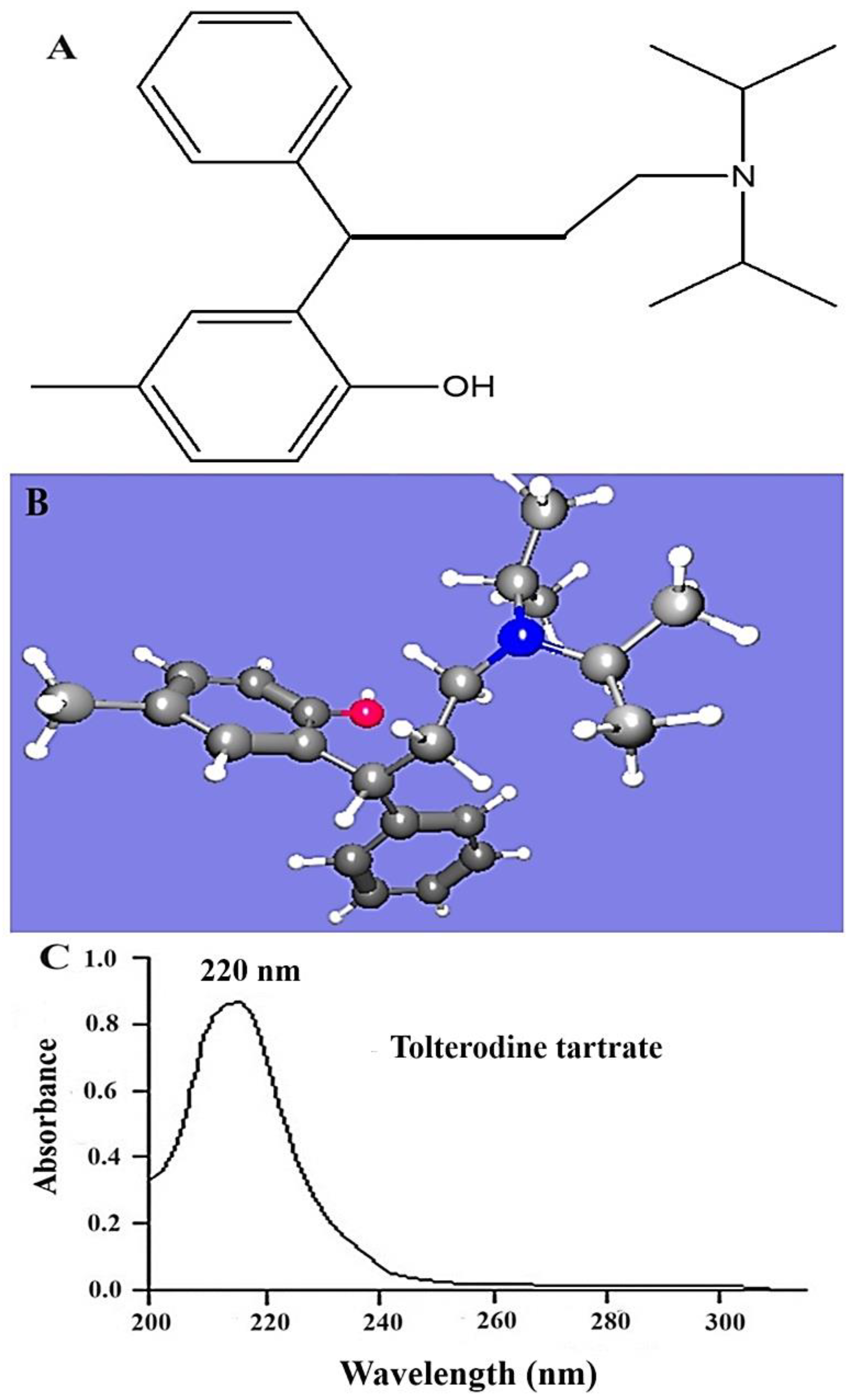


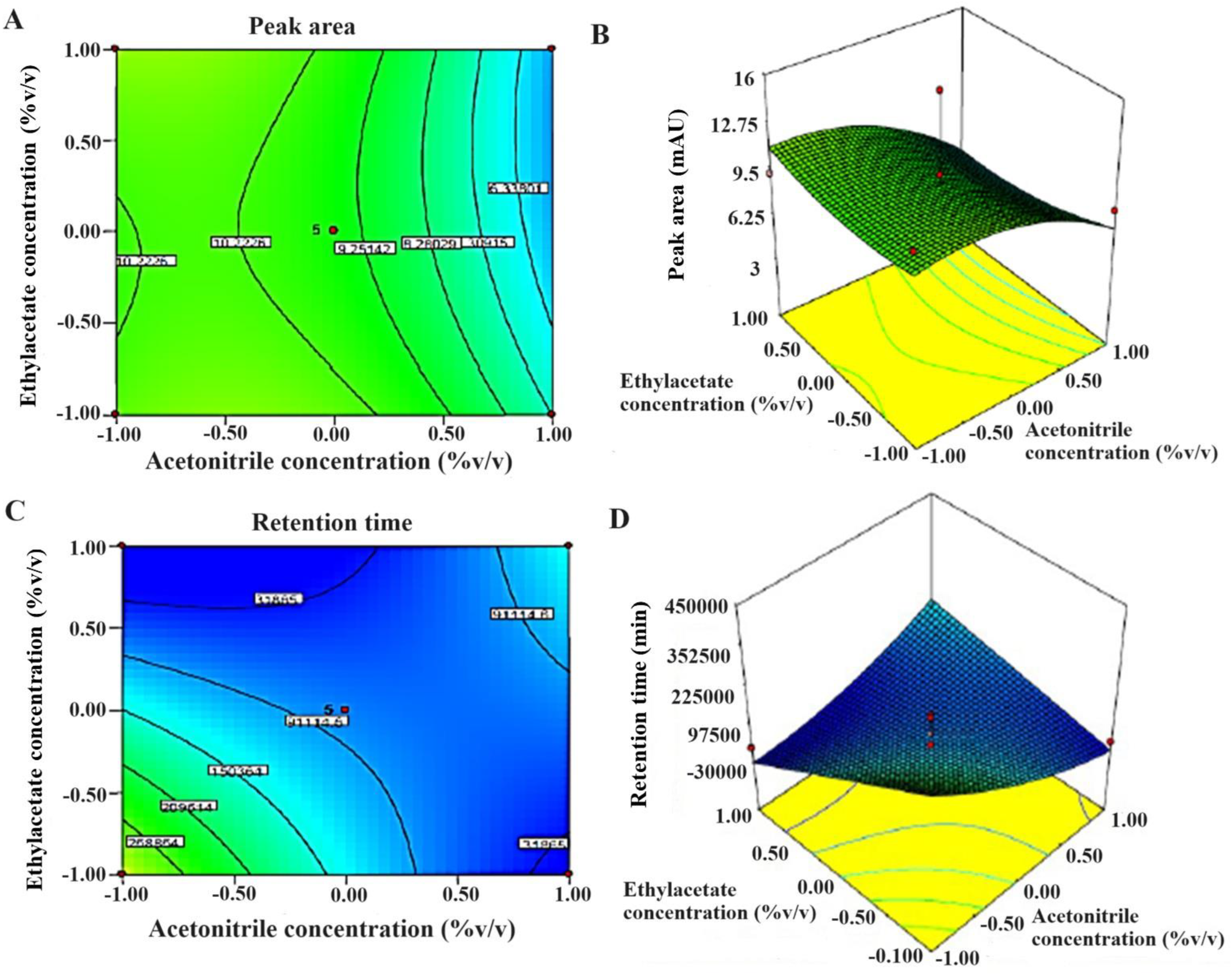
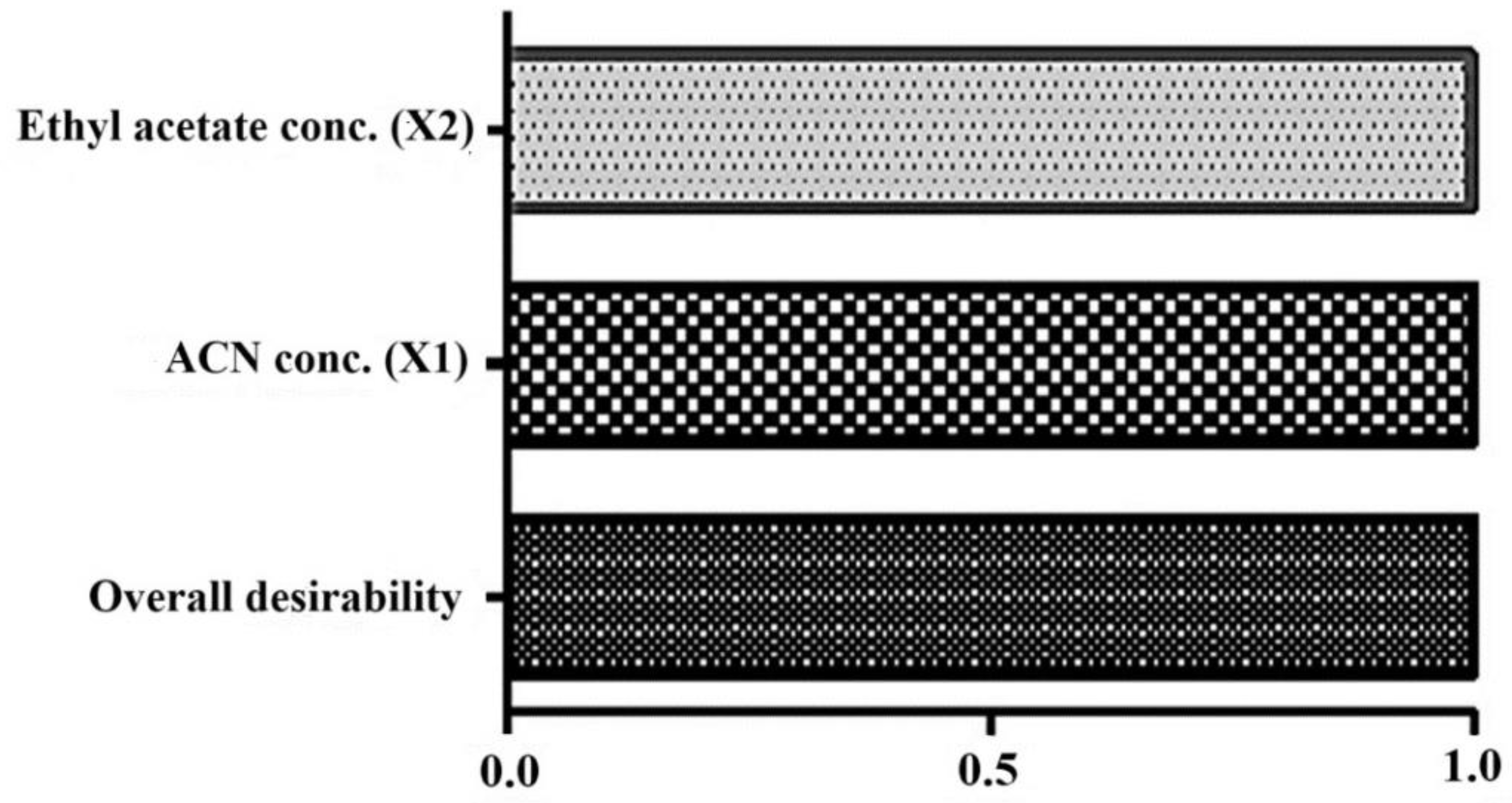
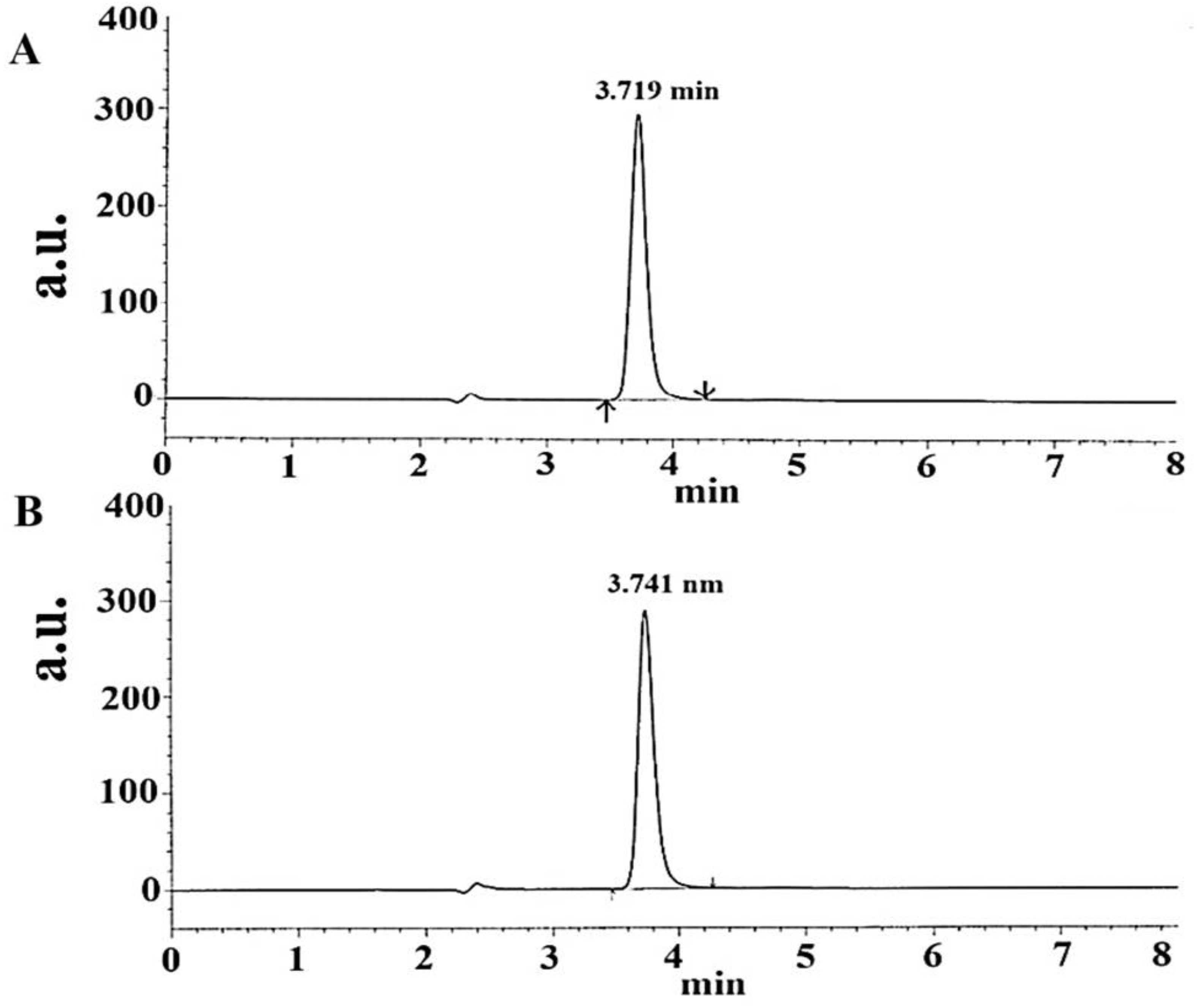
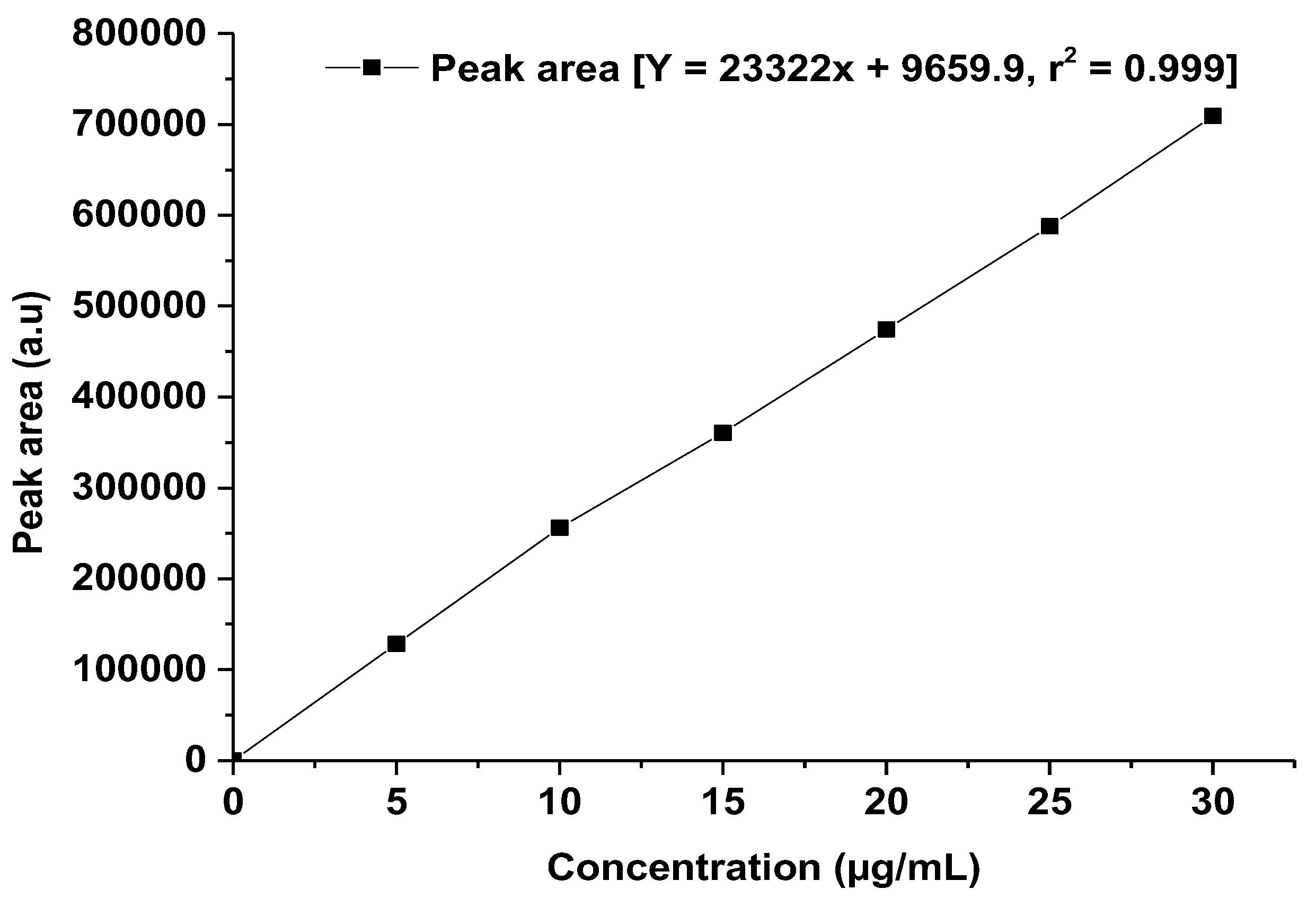

| Name | HSP Values Estimated | ||||||
|---|---|---|---|---|---|---|---|
| Excipients | Predicted Solubility (% w/v) @45 °C | δd | δp | δh | δt | MVol | HSP Distance |
| TOT | - | 17.6 | 2.4 | 4.6 | 18.3 | 333.8 | - |
| Water | 1.15 | 15.6 | 16.0 | 42.0 | 46.8 | 18 | 40.0 |
| Methanol | 1.72 | 16.4 | 12.3 | 21.7 | 29.9 | 41.1 | 19.9 |
| Ethanol | 0.92 | 15.6 | 9.3 | 17.2 | 25.0 | 58.2 | 14.9 |
| Propylene glycol | 1.28 | 17.1 | 9.1 | 19.8 | 27.6 | 90.9 | 16.6 |
| Ethylene glycol | 1.53 | 17.3 | 10.2 | 22.1 | 29.8 | 74 | 19.2 |
| Dimethyl sulfoxide | 2.36 | 18.4 | 14.6 | 8.1 | 24.9 | 81.3 | 12.8 |
| NMP | 1.16 | 17.9 | 9.9 | 7.4 | 21.8 | 99.7 | 8.0 |
| Acetonitrile | 1.84 | 15.6 | 16.6 | 8.3 | 24.3 | 53.4 | 15.2 |
| Ethyl acetate | 2.17 | 15.7 | 6.3 | 7.5 | 18.5 | 97.6 | 6.2 |
| DMA | 1.57 | 17 | 11.6 | 10.2 | 23.0 | 94.9 | 10.8 |
| Trimethylamine | 1.70 | 14.8 | 2.8 | 2.9 | 15.3 | 137.3 | 5.9 |
| Predicted HSP and RED parameters for the suggested combinations of solvents | |||||||
| Binary solvents | Solvents predicted | % | RED | δd | δp | δh | |
| Set I | EA | 70 | 1.0 | 15.7 | 9.1 | 6.9 | |
| ACN | 30 | ||||||
| Set II | EA | 70 | 1.0 | 15.5 | 7.4 | 11.7 | |
| Methanol | 30 | ||||||
| Set III | EA | 60 | 1.2 | 15.4 | 8.1 | 13.2 | |
| Methanol | 40 | ||||||
| Set IV | EA | 60 | 1.0 | 15.6 | 10.4 | 6.8 | |
| ACN | 40 | ||||||
| Set V | EA | 50 | 0.9 | 15.6 | 11.7 | 6.7 | |
| ACN | 50 | ||||||
| SMILE | |||||||
| TOT | Cc1ccc(c(c1)[C@H](CCN(C(C)C)C(C)C)c2ccccc2)O | ||||||
| Water | OH | ||||||
| Methanol | CO | ||||||
| Acetonitrile | CC#N | ||||||
| PG | CC(CO)O | ||||||
| EG | C(CO)O | ||||||
| Ethyl acetate | CCOC(=O)C | ||||||
| Dimethyl sulfoxide | CS(=O)C | ||||||
| NMP (1-Methyl-2-pyrrolidinone) | CN1CCCC1=O | ||||||
| N, N-dimethyl acetamide | CC(=O)N(C)C | ||||||
| Trimethylamine | CCN(CC)CC | ||||||
| Factors | Name of Selected Factors | Level | ||||||
|---|---|---|---|---|---|---|---|---|
| (−1) | (+1) | Response | ||||||
| A | Acetonitrile content (% v/v) | 40 | 50 | Peak area (mAU) | ||||
| B | Flow rate (mL/min) | 1.0 | 1.5 | |||||
| C | Column temperature (°C) | 20 | 25 | |||||
| D | Trimethylamine (% v/v) | 5 | 10 | Retention time (min) | ||||
| E | Injection volume (µL) | 10 | 20 | |||||
| F | Ethyl acetate content (% v/v) | 35 | 45 | |||||
| G | Sample temperature (°C) | 15 | 20 | |||||
| Run | A | B | C | D | E | F | G | |
| 1 | +1 | +1 | −1 | −1 | +1 | +1 | −1 | |
| 2 | −1 | +1 | +1 | −1 | −1 | +1 | +1 | |
| 3 | +1 | −1 | +1 | +1 | −1 | +1 | −1 | |
| 4 | −1 | +1 | +1 | +1 | +1 | −1 | −1 | |
| 5 | −1 | −1 | −1 | +1 | +1 | +1 | +1 | |
| 6 | −1 | −1 | −1 | −1 | −1 | −1 | −1 | |
| 7 | +1 | +1 | −1 | +1 | −1 | −1 | +1 | |
| 8 | +1 | −1 | +1 | −1 | +1 | +1 | +1 | |
| Factors and Their Levels | Responses | Goal | ||
|---|---|---|---|---|
| Design Run | A | B | ||
| 1 | 0 | 0 | Peak area (mAU) | Maximum |
| 2 | +1 | 0 | Peak retention time (min) | Minimum |
| 3 | 0 | 0 | ||
| 4 | −1 | 0 | ||
| 5 | −1 | −1 | ||
| 6 | −1 | +1 | ||
| 7 | 0 | 0 | ||
| 8 | 0 | +1 | ||
| 9 | 0 | 0 | ||
| 10 | −1 | +1 | ||
| 11 | +1 | +1 | ||
| 12 | 0 | 0 | ||
| 13 | +1 | −1 | ||
| Significant Factors | Low (−1) | Middle (0) | High (+1) | Mathematical Model | p-Value | F Value |
|---|---|---|---|---|---|---|
| X1: ACN concentration (% v/v) | 45 | 50 | 55 | Quadratic | 0.0045 | 1.89 |
| X2: Ethyl acetate concentration (% v/v) | 50 | 55 | 60 | Quadratic | 0.0062 | 1.18 |
| Chromatographic Parameters | Chromatographic Condition |
|---|---|
| Standard stock in mobile phase (µg/mL) | 100 |
| Mobile phase composition (v/v) | ACN:EA:TEA (50:45:05) |
| Detection wavelength (nm) as λmax | 220 |
| Flow rate (mL/min) | 1.2 |
| Sample size (µL) | 20 |
| Samples | Amount Taken (µg/mL) | Amount Found (µg/mL) Mean ± S.D. | Amount Found (%) Mean ± S.D. | % R.S.D. * |
|---|---|---|---|---|
| Bulk mixture (I) | 15 | 14.97 ± 0.07 | 99.79 ± 0.49 | 0.495 |
| Tablet (II) ** | 15 | 14.97 ± 0.18 | 99.81 ± 1.18 | 1.18 |
| Linearity Parameters (n = 6) | ||||
|---|---|---|---|---|
| S. No. | Concentration (µg/mL) | Mean peak area ± S.D. * | % R.S.D. ** | |
| 1 | 5 | 128,288.2 ± 814.32 | 0.63 | |
| 2 | 10 | 256,183.4 ± 1468.84 | 0.57 | |
| 3 | 15 | 360,483.8 ± 2848.34 | 0.79 | |
| 4 | 20 | 474,384.8 ± 4588.022 | 0.97 | |
| 5 | 25 | 587,885.8 ± 5905.894 | 1.005 | |
| 6 | 30 | 709,248.4 ± 5077.497 | 0.72 | |
| Results of Recovery Study (n = 3) | ||||
| Ai (μg/mL) | X (%) | Ad (μg/mL) | % recovery | % R.S.D.* |
| 10 | 80 | 8 | 100.13 | 0.94 |
| 10 | 100 | 10 | 99.76 | 1.32 |
| 10 | 120 | 12 | 100.36 | 1.47 |
| Results of Repeatability Study | ||||
| Concentration (µg/mL) | Amount Found (mean ± S.D.) | % R.S.D. * | ||
| 15 | 99.63 ± 0.49 | 0.49 | ||
| Results of Precision Studies (Intra-day and Inter-day) | ||||
| Intra-day: Amount Found (%) | Inter-day: Amount Found (%) | |||
| Mean ± S.D. ** | % R.S.D. | Mean ± S.D. ** | % R.S.D. | |
| 101.1 ± 0.94 | 0.93 | 99.56 ± 0.28 | 0.28 | |
| 99.73 ± 0.39 | 0.39 | 99.54 ± 0.34 | 0.34 | |
| 100.33 ± 0.30 | 0.30 | 99.90 ± 0.33 | 0.33 | |
| Results of Ruggedness Study | ||||
| % Amount Found (Mean ± S.D.) | % R.S.D.* | |||
| Analyte I | 99.87 ± 0.78 | 0.78 | ||
| Analyte II | 100.08 ± 0.86 | 0.86 | ||
| System Suitability Parameters | Proposed Method |
|---|---|
| No. of theoretical plates (N) | 4065 |
| Tailing factor (T) | 1.3 |
| Retention time (in min) | 3.7 |
| Result of Robustness Study | |||
|---|---|---|---|
| Sr. No. | Parameter | S.D. of Peak Area | % R.S.D. * |
| 1 | Mobile phase composition (a) 0.1% OPA: Methanol (45:55) | 3254.134 | 0.903 |
| (b) Phosphate buffer: ACN (55:45) | 3528.944 | 0.976 | |
| 2 | Changing flow rate (a) 1.0 mL/min | 2248.265 | 0.625 |
| (b) 1.4 mL/min | 2946.118 | 0.820 | |
| 3 | Changing the pH of the mobile phase (a) 1.5 | 3053.616 | 0.84 |
| (b) 2.5 | 3811.690 | 1.06 | |
| Summary of Validation Parameters | |||
| Parameters | Results | ||
| Linearity (range) | 5–30 µg/mL | ||
| Y = mx + C | Y = 22,936 X − 18,031 | ||
| LOD (µg/mL) | 0.13 | ||
| LOQ (µg/mL) | 0.40 | ||
| % Recovery * | 99.76–100.36% | ||
| Precision (% R.S.D.) | |||
| Intra-Day * | 0.30–0.93 | ||
| Inter-Day * | 0.28–0.33 | ||
| Repeatability ** | 0.49 | ||
| Ruggedness * | |||
| Analyst I | 99.87 ± 0.78 | ||
| Analyst II | 100.08 ± 0.86 | ||
| PK Parameters | Analyte II | Analyte I |
|---|---|---|
| Dose (mg/kg) * | 10.0 | 10.0 |
| AUC0-t (nmol·h/L) | 9.8 ± 0.97 | 16.3 ± 0.39 |
| AUC0-∞ (nmol·h/L) | 10.0 ± 0.9 | 16.6 ± 0.4 |
| Cmax (nmol/L) | 2.2 ± 0.1 | 3.5 ± 0.25 |
| Tmax (h) | 2.0 | 2.0 |
| T1/2 (h) | 2.1 ± 0.14 | 1.8 ± 0.01 |
| Ke (h−1) | 0.33 | 0.385 |
| Clearance (L/h·kg) | 53.6 | 32.28 |
Disclaimer/Publisher’s Note: The statements, opinions and data contained in all publications are solely those of the individual author(s) and contributor(s) and not of MDPI and/or the editor(s). MDPI and/or the editor(s) disclaim responsibility for any injury to people or property resulting from any ideas, methods, instructions or products referred to in the content. |
© 2024 by the authors. Licensee MDPI, Basel, Switzerland. This article is an open access article distributed under the terms and conditions of the Creative Commons Attribution (CC BY) license (https://creativecommons.org/licenses/by/4.0/).
Share and Cite
Patil, T.; Siddique, M.U.M.; Shelke, M.; Ramzan, M.; Patil, M.; Shahid, M. Development and Validation of HSPiP- and Optimization-Assisted Method to Analyze Tolterodine Tartrate in Pharmacokinetic Study. Processes 2024, 12, 2164. https://doi.org/10.3390/pr12102164
Patil T, Siddique MUM, Shelke M, Ramzan M, Patil M, Shahid M. Development and Validation of HSPiP- and Optimization-Assisted Method to Analyze Tolterodine Tartrate in Pharmacokinetic Study. Processes. 2024; 12(10):2164. https://doi.org/10.3390/pr12102164
Chicago/Turabian StylePatil, Tosh, Mohd Usman Mohd Siddique, Madhav Shelke, Mohhammad Ramzan, Mrunali Patil, and Mudassar Shahid. 2024. "Development and Validation of HSPiP- and Optimization-Assisted Method to Analyze Tolterodine Tartrate in Pharmacokinetic Study" Processes 12, no. 10: 2164. https://doi.org/10.3390/pr12102164






